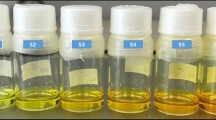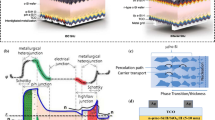Abstract
Metallic nanoparticles deposited semiconductor nanowires, a kind of heterostructures, show a remarkable property to strengthen optical and optoelectrical characteristics due to the coupling of surface plasmon with nanowires. The Silicon nanowires (SiNWs) are synthesized with metal-assisted chemical etching with different etching duration. Then silver nanoparticles (AgNPs) are deposited by the electroless deposition method over SiNWs, by maintaining the optimum deposition parameter. Here, the nanowire structures provided the flexibility to incorporate multiple metallic nanoparticles in a single system, which could have multiple applications in nanotechnology. Improved light absorption, increased surface area and enhanced charge carrier mobility make this substrate useful for next-generation photovoltaic cells. We experimentally measured the roughness of SiNWs and Ag-deposited SiNWs using atomic force microscopy, crystallite size using X-ray diffraction, optical reflectance by UV–visible spectroscopy, vibration and stretching of bonds by Fourier transform infrared spectroscopy and modified bandgap by photoluminescence spectroscopy. Our studies show that the change in the behaviour of SiNWs with deposition of AgNPs exhibits multifunctional properties, which can be of great significance in the field of nanowire solar cells, nanoelectronic devices, biological sensors, thermoelectric generators and high-efficiency photovoltaic cell.
Similar content being viewed by others
Data Availability
The datasets generated during the current study are available from the corresponding author upon reasonable request.
References
Chen R et al (2012) Tailoring optical properties of silicon nanowires by au nanostructure decorations: Enhanced Raman scattering and photodetection. J Phys Chem C 116:4416–4422
Hutagalung SD, Fadhali MM, Areshi RA, Tan FD (2017) Optical and Electrical Characteristics of Silicon Nanowires Prepared by Electroless Etching. Nanoscale Res. Lett. 12:425
Wagner RS, Ellis WC (1964) Vapor-liquid-solid mechanism of single crystal growth. Appl Phys Lett 4:89–90
Demichel O et al (2009) Photoluminescence of silicon nanowires obtained by epitaxial chemical vapor deposition. Phys E Low-Dimensional Syst Nanostructures 41:963–965
Fukata N, Oshima T, Tsurui T, Ito S, Murakami K (2005) Synthesis of silicon nanowires using laser ablation method and their manipulation by electron beam. Sci Technol Adv Mater 6:628–632
Kumar RR, Rao KN, Phani AR (2012) Growth of silicon nanowires by electron beam evaporation using indium catalyst. Mater Lett 66:110–112
Xu T et al (2011) Synthesis of long group IV semiconductor nanowires by molecular beam epitaxy. Nanoscale Res Lett 6:1–7
Li X, Bonn PW (2000) Metal-assisted chemical etching in HF/H2O2 produces porous silicon. Appl Phys Lett 77:2572–2574
Watson KJ, Zhu J, Nguyen SBT, Mirkin CA (1999) Hybrid nanoparticles with block copolymer shell structures. J Am Chem Soc 121:462–463
Weimer AW (2019) Particle atomic layer deposition. J nanoparticle Res an Interdiscip forum nanoscale Sci Technol 21(9)
Nakano M, Fujiwara T, Koga N (2016) Thermal Decomposition of Silver Acetate: Physico-Geometrical Kinetic Features and Formation of Silver Nanoparticles. J Phys Chem C 120:8841–8854
Kim M et al (2014) Hydrothermal synthesis of metal nanoparticles using glycerol as a reducing agent. J Supercrit Fluids 90:53–59
Betancourt-Galindo R et al (2014) Synthesis of copper nanoparticles by thermal decomposition and their antimicrobial properties. J Nanomater 2014:7–11
Zhu J, Kim K, Liu Z, Feng H, Hou S (2014) Electroless Deposition of Silver Nanoparticles on Graphene Oxide Surface and Its Applications for the Detection of Hydrogen Peroxide. Electroanalysis 26:2513–2519
Rao GPC, Tharmaraj V, Yang J (2015) Surfactant-assisted electroless deposition of silver nanoparticles on Ge crystal for ultra-sensitive detection by surface-enhanced infrared absorption spectroscopy. RSC Adv 5:20390–20395
Liao W, Liu K, Chen Y, Hu J, Gan Y (2021) Au–Ag bimetallic nanoparticles decorated silicon nanowires with fixed and dynamic hot spots for ultrasensitive 3D SERS sensing. J Alloys Compd 868:159136
Mahmud S et al (2019) Tailored Engineering of Bimetallic Plasmonic Au@Ag Core@Shell Nanoparticles. ACS Omega 4:18061–18075
Rani S, Shukla AK (2021) Investigation of silver decorated silicon nanowires as ultrasensitive and cost-effective surface-enhanced Raman substrate. Thin Solid Films 723:138595
Leonardi A, Faro A, Lo MJ, Irrera A (2021) Silicon nanowires synthesis by metal-assisted chemical etching: A review. Nanomaterials 11:1–24
Meng H, Fan K, Low J, Yu J (2016) Electrochemically reduced graphene oxide on silicon nanowire arrays for enhanced photoelectrochemical hydrogen evolution. Dalt Trans 45:13717–13725
Xu L, Li F, Liu Y, Yao F, Liu, S (2019) Surface Plasmon Nanolaser: Principle, Structure, Characteristics and Applications. Applied Sciences 9
Zamchiy AO et al (2018) Deposition time dependence of the morphology and properties of tin-catalyzed silicon oxide nanowires synthesized by the gas-jet electron beam plasma chemical vapor deposition method. Thin Solid Films 654:61–68
Sivakov VA, Voigt F, Berger A, Bauer G, Christiansen SH (2010) Roughness of silicon nanowire sidewalls and room temperature photoluminescence. Phys. Rev. B - Condens. Matter Mater. Phys. 82:1–6
Ghosh R, Pal A, Giri PK (2015) Quantitative analysis of the phonon confinement effect in arbitrarily shaped Si nanocrystals decorated on Si nanowires and its correlation with the photoluminescence spectrum. J Raman Spectrosc 46:624–631
Rouis A, Hizem N, Hassen M, Kalboussi A (2022) Electrical Properties of Silicon Nanowires Schottky Barriers Prepared by MACE at Different Etching Time. Silicon 14:4731–4737
Acknowledgements
Thanks for the strong support from the Nanoscale Research Facility and Central Research Facility of IIT Delhi for characterization facilities and the Council of Scientific and Industrial Research New Delhi (CSIR).
Funding
Savita Rani acknowledges the Council of Scientific & Industrial Research New Delhi grant number (09/086(1343)/2018-EMR-I) for financial support. All the other authors declare that no funds or support were received during this research work.
Author information
Authors and Affiliations
Contributions
Savita Rani: Conceptualization, Methodology, Writing-Original draft preparation, Visualization, Investigation, Validation, Result Analysis, Writing-Reviewing and Editing. Rangeeta Dhaka: I-V Result Analysis A.K. Shukla: Supervision, Reviewing and Editing.
Corresponding author
Ethics declarations
Competing Interests
The authors declare no competing interests.
Consent for Publication
Not applicable.
Consent for Participate
Not applicable.
Ethics Approval
Not applicable.
Competing Interest
The authors have no relevant financial or non-financial interests to disclose.
Additional information
Publisher's Note
Springer Nature remains neutral with regard to jurisdictional claims in published maps and institutional affiliations.
Rights and permissions
Springer Nature or its licensor (e.g. a society or other partner) holds exclusive rights to this article under a publishing agreement with the author(s) or other rightsholder(s); author self-archiving of the accepted manuscript version of this article is solely governed by the terms of such publishing agreement and applicable law.
About this article
Cite this article
Rani, S., Dhaka, R. & Shukla, A.K. Next-generation Cost- Effective Photovoltaic Cell with Tailored Structural and Optical Properties of Silicon nanowires with Silver Nanoparticle Deposition. Silicon 15, 7489–7497 (2023). https://doi.org/10.1007/s12633-023-02601-5
Received:
Accepted:
Published:
Issue Date:
DOI: https://doi.org/10.1007/s12633-023-02601-5




